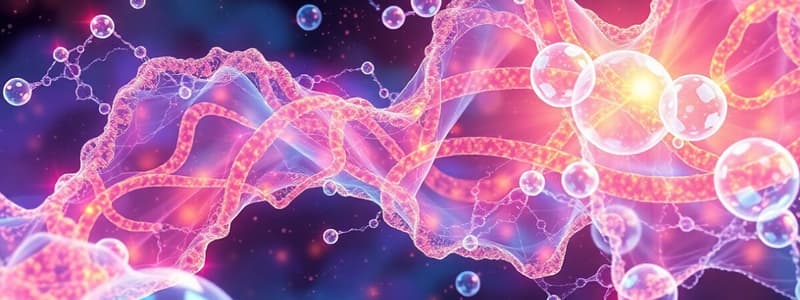Podcast
Questions and Answers
What is the primary mechanism through which valproic acid augments GABA release?
What is the primary mechanism through which valproic acid augments GABA release?
- Inhibiting GABA reuptake
- Directly stimulating GABA receptors
- Inhibiting glutamate synthesis
- Inhibiting GABA degradation via GABA-transaminase (correct)
What is a common mild adverse effect of valproate?
What is a common mild adverse effect of valproate?
- Polycystic ovarian syndrome
- Fulminant hepatitis
- Cognitive impairment
- Anorexia (correct)
What is a rare but serious adverse effect associated with valproate in children?
What is a rare but serious adverse effect associated with valproate in children?
- Pancreatitis
- Thrombocytopenia
- Weight gain
- Fulminant hepatitis (correct)
What is the plasma protein binding percentage of valproic acid?
What is the plasma protein binding percentage of valproic acid?
Which of the following side effects is dose-related when taking valproate?
Which of the following side effects is dose-related when taking valproate?
Which of the following statements regarding the metabolism of valproic acid is true?
Which of the following statements regarding the metabolism of valproic acid is true?
What potential serious adverse effect can occur from the use of valproate in children under 3 years old?
What potential serious adverse effect can occur from the use of valproate in children under 3 years old?
What should be monitored regularly due to potential side effects of valproate?
What should be monitored regularly due to potential side effects of valproate?
Long-term use of valproate in young girls has been associated with which of the following?
Long-term use of valproate in young girls has been associated with which of the following?
What is the typical half-life of valproic acid in the plasma?
What is the typical half-life of valproic acid in the plasma?
What increased risk is associated with long-term use of valproate in young girls?
What increased risk is associated with long-term use of valproate in young girls?
What is a potential risk of using valproate during pregnancy?
What is a potential risk of using valproate during pregnancy?
Which of the following effects does valproic acid NOT have on exogenously applied GABA?
Which of the following effects does valproic acid NOT have on exogenously applied GABA?
Study Notes
Mechanism of Action
- Weak attenuation of Ca2+ mediated 'T' current, similar to ethosuximide.
- Enhances GABA release by inhibiting degradation via GABA-transaminase and possibly increasing synthesis from glutamic acid.
- Responses to exogenous GABA remain unchanged.
Pharmacokinetics
- Good oral absorption of valproic acid.
- 90% protein binding in plasma.
- Completely metabolized in the liver via oxidation (primarily CYP2C9 and CYP2C19) and glucuronide conjugation; some metabolites are active.
- Excreted in urine; plasma half-life is 10–15 hours, but anticonvulsant effects persist longer.
Adverse Effects
- Relative low toxicity profile.
- Common mild side effects: anorexia, vomiting, diarrhea, heartburn.
- Dose-related side effects include drowsiness, ataxia, and tremor; cognitive and behavioral effects minimal.
- Observed side effects: alopecia, hair curling, weight gain, increased bleeding tendency.
- Rashes and thrombocytopenia occur infrequently as hypersensitivity reactions.
- Asymptomatic rise in serum transaminases warrants liver function monitoring.
Serious Risks
- Rarely, fulminant hepatitis, particularly in children under 3 years old; increased risk in patients with hepatic disease or those on other anticonvulsants or hepatotoxic drugs.
- Cases of pancreatitis reported.
- Long-term usage in young girls linked to polycystic ovarian disease and menstrual irregularities.
- Pregnant women should avoid valproate due to risks of spina bifida and other neural tube defects in offspring.
Studying That Suits You
Use AI to generate personalized quizzes and flashcards to suit your learning preferences.
Description
Explore the pharmacokinetics of valproic acid, including its interactions with GABA and calcium channels. This quiz covers key mechanisms of action, including how valproic acid enhances GABA release and details its absorption and metabolic processes in the liver. Test your understanding of this important anticonvulsant medication.




